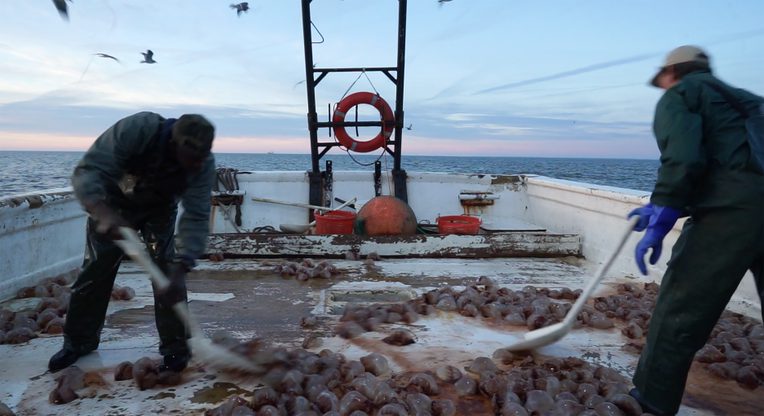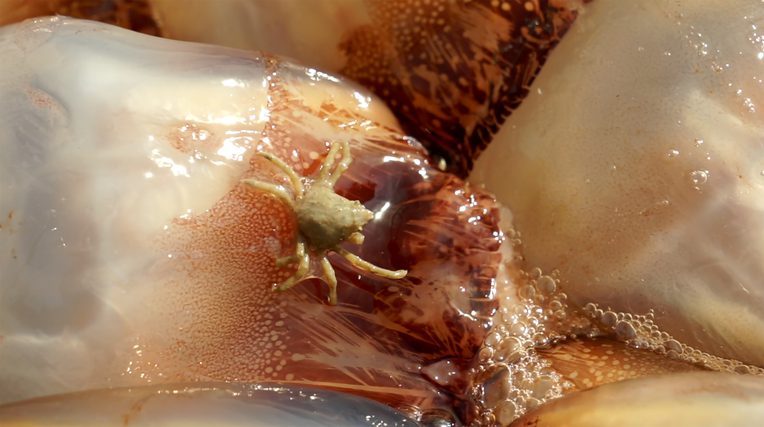A Correspondence of the Senses: Panesthesia as Research Method
From the Series: Correspondence
From the Series: Correspondence

To begin, please watch the following video:
I pulled into a dirt parking lot with one lone streetlight shining on a white pickup truck. Mosquitoes and moths swirled around in a tornado of ecstasy, and cicadas droned a midnight tune at a higher pitch than the gas generators. It was the middle of the night, yet when I turned around, the pier was bright with fluorescent light and the Blessed Assurance was full of activity for the coming jellyfish trawling trip. I lugged over my camera and audio gear, alone this time for a twenty-four-hour trip at sea with an all-male crew, about to engage in an exhausting interview practice—an immersive process that involves what I call the panesthetic method. The interview began by sonically linking myself to Wynn, the trawler’s captain, through a wireless lavalier microphone (or “lav”) for around eighteen hours. During this time, my research took many shapes and forms.

My approach to research is to frame a set of questions and/or a set of methodologies through a project. I have to make to think, and think to make. Through making, I enact theory. Theory enacts the making. Making enacts me, I enact it, and hopefully everything in the human/more-than-human ecosystem I am researching intra-acts (see Barad 1997) and intra-enacts to form a hot compost of embodied, tentacular (see Haraway 2016), weedy, fertile, permacultural knowledge. How to make with, or correspond (Ingold 2015), with the world in this way? How can we take up Karen Barad’s call to disengage individualistic inter-action and instead engage in mutually constitutive, coemerging worldmaking practices like intra-action (see also Omura et al. 2019)? And what does all this feel like in actual real practice? In response to Caroline Gatt and Joss Allen’s question “what is it about weeds that we want to explore?” I would say that they’ve been at the center of my interests for years. My own weed “built within the ruins” has been the study of anthropogenically introduced invasive jellyfish blooms—a pelagic weed with massive consequences for ecosystems—as a harbinger for the Anthropocene.
One path that I’ve begun to explore is expanding the practice of interviewing, so common in ethnographic fieldwork and documentary filmmaking. However, stretching the limits of the interview led me to another method, which I’m calling panesthesia. The example I’ll give is one day of my fieldwork on a jellyfish trawling boat, in the small one-stoplight town of Darien, Georgia, in the United States.
Medically, panesthesia is the sum of all the sensations experienced by a person at a given moment, while panaesthetics has been repurposed to refer to the unity and diversity of all art forms (Albright 2014). At its base, panesthetics approximates the experience of accounting for multiple senses in the process of creating knowledge through research, though I anticipate extending this definition in the future. One way I have explored panesthetics is through the durational interview. I argue that this type of sonic observational method enables a type of immersion and sensorial worldmaking and knowledge creation that isn’t possible through a direct-address interview.
Whether or not I was shooting Wynn, the key is that I was listening to his lav—his sound—with headphones at all times. I also recorded other sounds at the same time, such as when I was listening to the jellyfish “soup” underneath me in the hold of the boat with a hydrophone. These various sound sources created a layered effect of breathing, asthma, voice, clicks, and jelly gloop. Sounds, sensations, and smells from around me bled through as well: constant motor noise, water, wind, seagull cries, screeching ropes; the subtle shifts in my axis as I leaned front to back when the sea swelled, my fingers frozen from the wind; the smell of salt, decay, sweat, diesel, grease, bleach, and piss hit me in stages; the feel of how slippery the bell of a cannonball jellyfish was; and the sharp little claws of the long-nosed spidercrabs. These were not discrete observations, cataloged one by one, but rather an avalanche of sensations, information, experience, all entangled with each other (and my body) to produce a new assemblage.

About five hours in, at 8 a.m., Wynn prophetically mentions: “Let’s see if these bags hold up, is what worries me.” As he and his team crank the nets up, full of jellyfish, one of the two nets breaks and unravels, like a zipper being opened in one neat motion. Wynn loses the entire catch, as well as his net and his tripbell. This was a cataclysmic event in his world, one that he proceeded to narrate to everyone he knew on and off the boat for a good part of the rest of the day. In turn, I was able to listen to many intimate phone and short-wave radio conversations, which traced a wide network of (odd?) kin. Many of the retellings focused on the deep precarity facing him and other commercial fisherman. This was tremendously useful for me to listen to and record, for it allowed me to become aware of a myriad of topics I would not have known how to raise or provoke. At the end of a phone call with a fellow “jellyballer” Wynn said: “I can’t do another year like I did this year. The boat ain’t gonna hold together, just ain’t gonna do it. Now I dunno what I’m gonna do but . . . they want to charge me $500 to park at the dock. Ain’t got that. Light bill’s due, water bill’s due, just cut off my cable . . . so I don’t know.” His friend responded: “I’m just one breakdown behind you, buddy. Just one breakdown behind you, that’s all. Just one breakdown and I’m out of commission.”
My original intent had been to find out all I could about the multispecies entanglements of cannonball jellyfish in this specific ecosystem, but in my quest to go beyond the human I had not considered Wynn and his community’s precarity as potentially integral to my research. His asthma flared up after the phone call, and his breathing grew labored—a sound I came to know intimately over the course of the day as the slightest bit of physical exertion on his part brought it out. His voice and bodily sounds were often disembodied for me, a kind of acousmêtre (see Chion 1999), taking on their own meanings in the disjuncture between the visual and the auditory. My own listening to Wynn changed: first focused on voice and information, then on mapping the network of friends and family to which he reached out via cellphone and short-wave radio, and eventually on the rhythm and cadence of his labor. Though Wynn was keenly aware of being listened to (at one point, he told me it felt like we were in a Bond movie where he could secretly speak to me), the difference for both of us was that I was not present in his immediate personal space, pointing a camera at him.
Instead it was the durational intravention, as Wendy Gunn describes it, and layers of senses—my panesthesia—that enabled a response-ability (Barad 2007) to the world around me: what the world/body-multiple within-me sensed, heard, saw, smelled, touched, and thought led to a panoply of new questions (see Mol 2002). On some level, we are doing panesthesia all the time, but it is unconscious, unnoticed.
I am advocating for a conscious noticing of all the senses at once as a fieldwork method, which can enable a nonlinguistic attunement with the world both human and more-than-human. This attunement gives rise to new questions, new perspectives, and new entanglements. These layers of senses transformed my interview practice, going beyond an anthropocentric Q&A format. Panesthesia allows me to form an active correspondence with the world, an active assembling of senses that brings together the realization that the boat is an ecosystem in its own right, and I only one of its participants: humans, nonhumans, more-than humans intra-acting to form a strange passing through the seas of both water and time.
Albright, Daniel. 2014. Panaesthetics: On the Unity and Diversity of the Arts. New Haven, Conn.: Yale University Press.
Barad, Karen. 2007. Meeting the Universe Halfway: Quantum Physics and the Entanglement of Matter and Meaning. Durham, N.C.: Duke University Press.
Chion, Michel. 1999. The Voice of Cinema. Translated by Claudia Gorbman. New York: Columbia University Press. Originally published in 1982.
Haraway, Donna. 2016. Staying with the Trouble: Making Kin in the Chthulucene. Durham, N.C.: Duke University Press.
Ingold, Tim. 2015. “Foreword.” In Non-Representational Methodologies: Re-Envisioning Research, edited by Phillip Vannini, vii–x. New York: Routledge.
Mol, Annemarie. 2002. The Body Multiple: Ontology in Medical Practice. Durham, N.C.: Duke University Press.
Omura, Keiichi, Grant Jun Otsuki, Shiho Satsuka, and Atsuro Morita, eds. 2019. The World Multiple: The Quotidian Politics of Knowing and Generating Entangled Worlds. New York: Routledge.